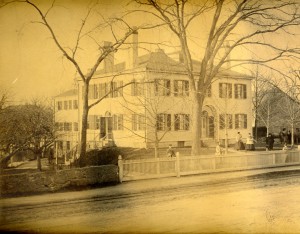 A few months ago, my husband and I moved to Dorchester, Massachusetts, to work as caretakers of the William Clapp house, which was built in 1806. William Clapp and his wife, Elizabeth (Humphreys) Clapp, were married in the parlor of this house on 15 December 1806. They had nine children, two of whom died at a young age. This family also suffered the loss of three more children in November of 1838 from typhoid fever. Rebecca Clapp, aged twenty, and James Clapp, aged nineteen, died on the same day, and their brother Alexander Clapp, aged seventeen, died four days later. Continue reading Leaving their mark
A few months ago, my husband and I moved to Dorchester, Massachusetts, to work as caretakers of the William Clapp house, which was built in 1806. William Clapp and his wife, Elizabeth (Humphreys) Clapp, were married in the parlor of this house on 15 December 1806. They had nine children, two of whom died at a young age. This family also suffered the loss of three more children in November of 1838 from typhoid fever. Rebecca Clapp, aged twenty, and James Clapp, aged nineteen, died on the same day, and their brother Alexander Clapp, aged seventeen, died four days later. Continue reading Leaving their mark
Category Archives: Family Stories
A price beyond rubies
 In 2010, I visited the town of Rose in Cumberland County, Nova Scotia, to meet the nieces and nephew of Ada Lophemia (Halliday) Clark. Ada was the second wife of my great-grandfather Thomas William Clark of Moncton, New Brunswick. Within the walls of their ancestral home in Rose I heard stories of a great-grandfather who died more than a quarter-century before I was born, a man that my own father only mentioned by name, and whose face is still unknown to me. No photograph is known to exist of my great-grandfather. Nonetheless, through genealogical research and family stories I have been able to draw a picture of what he was like, with a rough sense of his life story. Continue reading A price beyond rubies
In 2010, I visited the town of Rose in Cumberland County, Nova Scotia, to meet the nieces and nephew of Ada Lophemia (Halliday) Clark. Ada was the second wife of my great-grandfather Thomas William Clark of Moncton, New Brunswick. Within the walls of their ancestral home in Rose I heard stories of a great-grandfather who died more than a quarter-century before I was born, a man that my own father only mentioned by name, and whose face is still unknown to me. No photograph is known to exist of my great-grandfather. Nonetheless, through genealogical research and family stories I have been able to draw a picture of what he was like, with a rough sense of his life story. Continue reading A price beyond rubies
Shoes in the attic
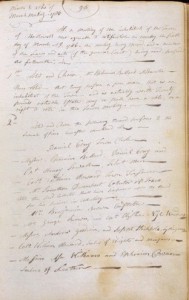
When Chicken Little said the sky was falling, I did not take that to mean corsets and shoe lasts. I’ve learned while restoring and renovating my old house that the unexpected is to be expected, that making a change here means a ripple effect of changes there, and that what goes up must come down, usually when I’m not expecting it.
When our carpenters were working on the original back staircase, everything seemed to fall out of the old ceiling: square hand-cut nails, buttons, a hand-cut wooden spoon, a wooden shoe last, some small bones I’d rather not discuss, but not one bag of Colonial-era coin, no now-priceless daily diaries. Continue reading Shoes in the attic
Family plots: Part Two
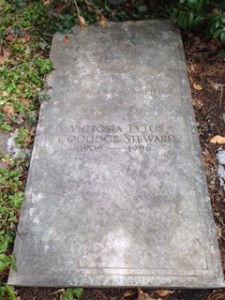 Riffing on something Chris Child wrote about collecting photos of family members in July, I thought I might do something similar with information about family burial plots. Such an exercise leans heavily on Findagrave.com (where some of the images may be found), although in my case I also have the notes compiled by my great-aunt Margaret Steward in 1966 as a resource for my research.
Riffing on something Chris Child wrote about collecting photos of family members in July, I thought I might do something similar with information about family burial plots. Such an exercise leans heavily on Findagrave.com (where some of the images may be found), although in my case I also have the notes compiled by my great-aunt Margaret Steward in 1966 as a resource for my research.
My grandparents are easy: my father’s parents (and stepmother) are buried at Hamilton Cemetery in Massachusetts, while my mother’s parents (and stepmother) are buried at Arlington National Cemetery in Virginia. I was present for my paternal grandfather’s memorial service in 1991, my maternal grandfather’s burial in 1994, and for my paternal step-grandmother’s memorial service in 1996. Continue reading Family plots: Part Two
Delayed recording of deeds

While working on the Early New England Families Study Project sketch on Samuel Maverick this week, I came across a deed from 1636 that was not recorded until 1717! This is a good reminder that deeds are entered into the official books by the date they were recorded, not by the date they were made. Thus, one can never assume that a deed recorded after a person’s death – even decades after – is not that person’s deed.
A sale of land was legal, whether or not the deed was recorded, although recording the transaction helped to prove legality if disputed. Recording might be delayed until the land was sold the next time, which might be a generation or two later. Continue reading Delayed recording of deeds
Mrs. Gray on marriage
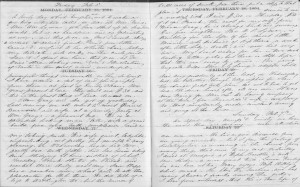
Regina Shober Gray’s diary abounds in telling details and contemporary gossip; in some ways, her views on the marriages (and marriage prospects) of her friends call out some of her choicest phrasing:
Boston, ca. Sunday, 5 January 1873: Our cousin John C. Gray, jr.[1]’s engagement to Nina Mason (daughter of the late Rev. Charles M.[2]) was announced yesterday. She is 19 – he 33 or 34, a great difference at her age. On dit[3] he fell very desperately in love with her when travelling in Europe – and that her mother would not consent to any engagement till the child had seen at least one year of home society, thinking very naturally Nina was too young & inexperienced to know her own mind.
Sunday, 19 January 1873: Poor young Nellie U[4]’s miserable entanglement with Charles Walker has come to a crisis at last, after having been town talk for more than two years; and in all that time, no whisper or suspicion has reached her parents’ ears. Continue reading Mrs. Gray on marriage
“Free access”
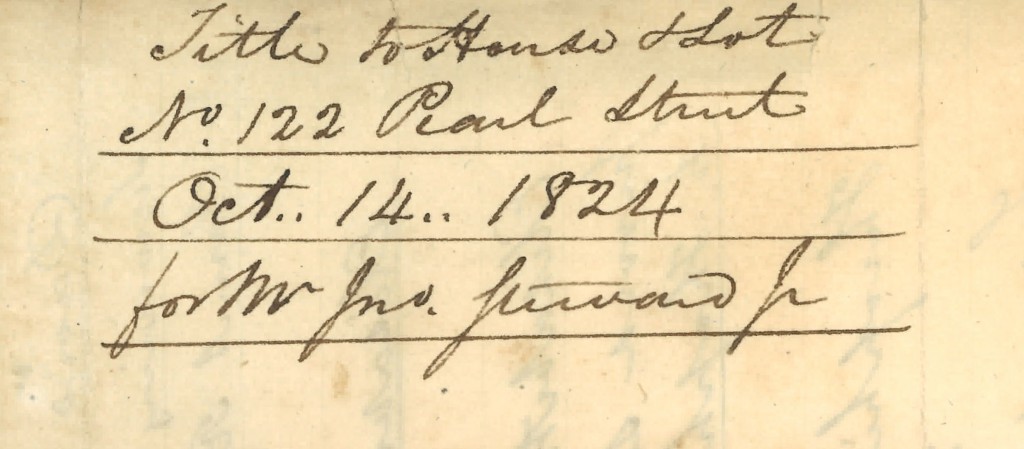 It was a matter of some pride to my grandfather that his great-grandfather John Steward (1777–1854) bought the (downtown) Gracie Mansion[1] when he moved to New York more than two hundred years ago. Perhaps so, as John Steward lived at 1 Pearl Street until he moved far uptown to a new house at Fifth Avenue and Twenty-first Street, shortly before his death in 1854. The title abstracts in my grandfather’s box of family papers concerning John’s Pearl Street real estate are for some other properties – one was his store, at 80 Pearl Street,[2] while another (122 Pearl Street) was purchased from Mr. and Mrs. Charles McEvers. Continue reading “Free access”
It was a matter of some pride to my grandfather that his great-grandfather John Steward (1777–1854) bought the (downtown) Gracie Mansion[1] when he moved to New York more than two hundred years ago. Perhaps so, as John Steward lived at 1 Pearl Street until he moved far uptown to a new house at Fifth Avenue and Twenty-first Street, shortly before his death in 1854. The title abstracts in my grandfather’s box of family papers concerning John’s Pearl Street real estate are for some other properties – one was his store, at 80 Pearl Street,[2] while another (122 Pearl Street) was purchased from Mr. and Mrs. Charles McEvers. Continue reading “Free access”
“The bitter end”

One of the most remarkable entries in the Regina Shober Gray diary – a document not short on remarkable entries – is the one where the diarist recounts a vivid dream in which she is a murderess. In the dream, as she says, she felt no “remorse or horror (for I did not deny the murder), but only a dull, stolid amazement that I should find myself in this disastrous, mortifying position.”[1]
The cool appraisal with which the diarist considers her feelings and motivations, the lack of self-consciousness about her professed guilt, and the ease with which she insists that she is a “lady” suggest that the diary was never meant to be read by others. Continue reading “The bitter end”
Far afield
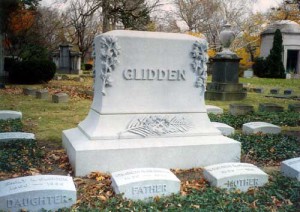
There is a tendency, I think, to imagine that our ancestors moved around far less than we do, that they were parked in one spot for years at a time – perhaps they were born, married, and died in the same place. If, in fact, they emigrated to another country, this was a one-time thing, for by doing so they must have exhausted their wanderlust.
The experience of my own ancestors refutes this truism, although I certainly do have forebears who stayed in one place for generations at a time. Continue reading Far afield
Now, it’s time to write
 [Editor’s Note: Between June and August of this year, Alicia wrote two series on her research and writing methodologies. In the interest of bringing them together, and sharing them with a fresh audience, they are offered again, with some of the author’s commentary. The first of these two posts appeared here:]
[Editor’s Note: Between June and August of this year, Alicia wrote two series on her research and writing methodologies. In the interest of bringing them together, and sharing them with a fresh audience, they are offered again, with some of the author’s commentary. The first of these two posts appeared here:]
From Composition: Part One:
Many people enjoy fishing, but not as many enjoy cleaning the catch. That is why we all have piles of research sitting waiting to be compiled into finished accounts. In some cases we may have entered our data into a genealogical database, but as nice as they are for sorting a multitude of facts, there is still no replacement for a well-written genealogical story. Continue reading Now, it’s time to write